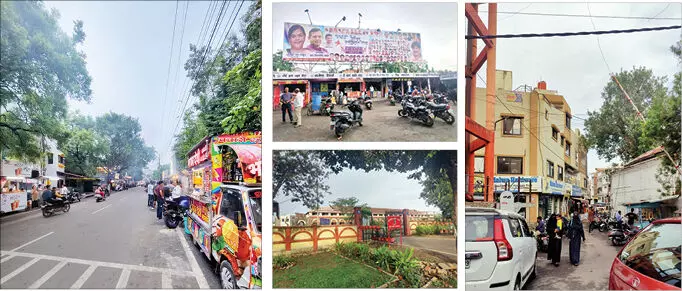Mhow: Of wild cats, street food, and retirees
A quaint cantonment town serves up an intriguing mix of new India’s ambitions and changes along with a healthy dose of retiree energy

Image courtesy: Shutapa Paul
A leopard is on the loose; its pugmarks showing up on the golf course, its lazy yet purposeful walks caught on CCTV cameras. The leopard was seen one night beside a thoroughfare sighted by a neighbour’s domestic staff. Not just the leopard, a mysterious tiger has also been doing the rounds of urban habitats while playing hide and seek with forest officials. And that's all that locals could talk about. The wild cats dominated almost all conversations over high teas and boozy dinners in the few days that I spent in a quaint cantonment-adjacent town last month, turning it into one of the most stimulating trips for me this year.
Mhow, under an hour away from India’s purportedly cleanest city, Indore, is many things. Mhow Cantt was established by the British in 1818 during the Third Anglo-Maratha War. John Malcolm had defeated the Holkars in 1817 and Mhow Cantt came up as a result of the ensuing Treaty of Mandsaur. Mhow is also the birthplace of social reformer BR Ambedkar, who drafted the Indian Constitution. Rich in history, few are aware of its retinue of famous contemporary inhabitants — Winston Churchill apparently spent a few months as a subaltern in his regiment; Bollywood actor, Anushka Sharma also spent her childhood in Mhow.
Tourist attractions such as Maheshwar, Mandav, Janapav, and a host of other locales lie at drivable distance from this town in Madhya Pradesh. However, today, the strongest connection for Mhow is the Indian army that houses three elite training divisions in Mhow — the Infantry School, the Army War College, and Military College of Telecommunication Engineering (MCTE).
Several retirees, including former Army officers, choose Mhow for the autumn and winter phase of their lives. They have left behind homes in other parts of the nation, bustling cities, native places, everything — to migrate to Mhow, building cosy bungalows or modern abodes as per personal preference with a passion of gardening, agriculture, and rainwater harvesting. It intrigued me — why Mhow? But in a short while, the answers emerged.
There’s just so much going on in that small cantonment and its adjacent areas. Officially now known as Dr Ambedkar Nagar, Mhow proffers a peaceful energy of retired bliss — green, open spaces, availability of land at affordable rates, a moderate climate that doesn’t jerk the senses, and yet proximity to the facilities and amenities of smart city, Indore. But most predominantly, it is its vibrant community that holds the key — old Parsi families living in 150+ year bungalows; locals who have over the years befriended Army officers and their families that fleetingly make Mhow their home; a community of friends that help, debate, party, and picnic throughout the week. The Covid-19 pandemic further strengthened the close-knit community with the younger generation reverse migrating from the big cities during the lockdown; many of whom now refuse to trade in the small-town life for big city rat races.
Mhow, interestingly, also gives a snapshot of small-town ambitions and unbridled desires that has overpowered the other India. Just visit the pulsating EatStreet in Mhow to witness the F&B ambitions of Indian youth strewn across a couple of town streets. From delicious vada pav being churned out by a Maharashtrian couple to interesting renditions of the humble Maggi by two young boys barely out of their teens, from Tandoori chai to Tandoori momo sold by a north-eastern couple, to social media trending Kulhad pizza, and a Goa-style hippie cafe called 'Chai Sutta Bar' where you can “cuddle the kulhad” (their words, not mine) — this is the vibe of the new tier 2 and 3 India, that is growing, consuming, and creating its own unique persona distinct from the outward razzmatazz of metros. This is ‘Bharat’ that has talent, opportunities, and market potential.
The town is also an example of a melting pot of communities and religions that while feeling the reverberations of fundamentalism is still able to keep the communal camaraderie alive. From loud azaans to eight-loudspeaker laden tempos talking about Hindutva, a proliferation of temples in every available space in the town centre, and yet bustling shops owned and operated by the Muslim community — it’s a delicious sample of a truly diverse India. The presence of the Indian army as the silent resident and local guardian surely helps.
There is also an ongoing struggle between the old and the new — beautiful colonial structures have been razed to the ground in the last few years, unfortunately making way for ugly, practical buildings. First, the Military Hospital vanished, rue the residents; as did a clutch of army bungalows replaced by garish monstrosities of modernity. Before the pandemic, there was talk of demolishing the heritage building of the Army Public School, which was thankfully stopped after an outpour of outrage from Mhow residents. Next on the anvil, could be the charming old dak ghar (post office).
It’s incredible that one can view the complex facets of a growing nation through the prism of one town. Meanwhile, as I write this, the leopard has been caught and released into the wilderness. The tiger, though, continues to be elusive and seems to be taunting the locals in the town and nearby villages by making sudden appearances. I’m sure his tales bewilder and entertain a bunch of jovial retirees, and sometimes their kids, as they sit down to tea.
The writer is an author and media entrepreneur. Views expressed are person




